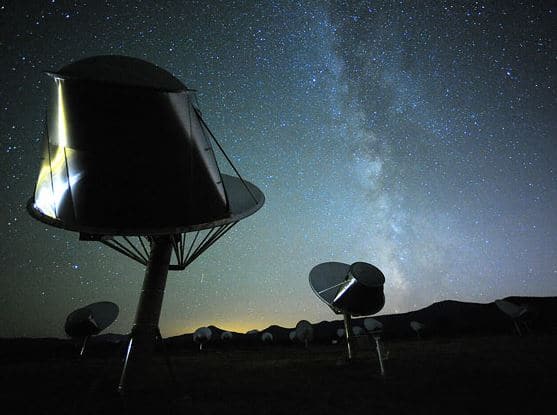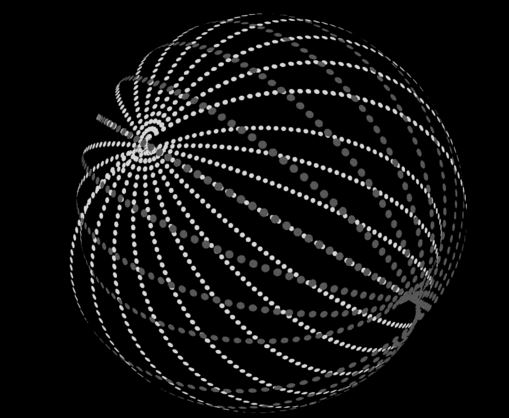A possible alien megastructure, which may have dimmed a star called KIC 8462852, showed no clear evidence for narrow-band or broad band signals between the frequencies of 1 and 10 GHz, say SETI scientists after using the Allen Telescope Array. This does not mean there is no giant alien structure out there, it means we do not yet have any proof.
Alien enthusiasts had become very excited at the news of a possible megastructure which made a star, informally known as Tabby’s Star, dim by more than 20%. They believe it could be a massive power station positioned in space to tap the star’s energy.
Even respectable scientists, who offered several natural explanations for the strong change in the star’s luminosity, have not discarded the possibility that a super-advanced civilization may have built a megastructure around Tabby’s Star, which causes the dimming.
 Allen Telescope Array. (Image: seti.org. Credit: Seth Shostak)
Allen Telescope Array. (Image: seti.org. Credit: Seth Shostak)
Dyson swarm of solar panels?
An example of a large-scale *astro-engineering project would be the construction of a Dyson swarm of solar panels – which would collect energy on a massive scale. Other possibilities include artificial space habitats, or even a planet-size object to provide a long-lasting signal to other galactic beings.
*Astro-engineering refers to structures at least the size of a planet.
Scientists at the SETI Institute trained the Allen Telescope Array, a radio telescope array situated at the Hat Creek Radio Observatory, 290 miles northeast of San Francisco, California, on the star for more than two weeks. The array consists of 42 antennas, each measuring 6 meters in size.
The scientists were looking out for two different types of radio signals:
1. Narrow-band signals, approximately 1 Hz in width. This could be a type of ‘hailing signal’ that a civilization might use to announce its presence. SETI scientists look out for narrow-band signals regularly.
2. Broad-band signals, that might be due to beamed propulsion within this star system. If there really are astro-engineering projects in the vicinity of KIC 8462852, there could well be spacecraft to service their activities. If these vessels are propelled by intense microwave beams, some of that energy might leak out in the form of broad-band radio.
 A Dyson Swarm surrounding a star. It is named after English-born American theoretical physicist and mathematician Freeman John Dyson (born 1923). Dyson said “One should expect that, within a few thousand years of its entering the stage of industrial development, any intelligent species should be found occupying an artificial biosphere which completely surrounds its parent star.” (Image: Wikipedia)
A Dyson Swarm surrounding a star. It is named after English-born American theoretical physicist and mathematician Freeman John Dyson (born 1923). Dyson said “One should expect that, within a few thousand years of its entering the stage of industrial development, any intelligent species should be found occupying an artificial biosphere which completely surrounds its parent star.” (Image: Wikipedia)
Seti Scientist, Dr. Gerry Harp, said:
“This is the first time we’ve used the Allen Telescope Array to look for relatively wide-band signals, a type of emission that is generally not considered in SETI searches.”
No clear evidence of alien signals
After gathering and analyzing the Array data, the researchers could find no clear evidence of either type of signal (ranging from 1 to 10 GHz). This discards the possibility of omnidirectional transmitters capable of about 100 times Earth’s total energy usage in the case of narrow-band signals, and 10 million times for broad band emissions.
In its website, the SETI institute wrote:
“While these limits are relatively high – a fact due primarily to the large distance (>1400 light-years) of KIC 8462852 – one should note the following: (1) The required transmitter power for the narrow-band signals could be reduced enormously if the signal is being deliberately beamed in our direction. (2) Microwave propulsion schemes would undoubtedly be beamed as well, and that would also reduce the minimum transmitter power necessary for detection by the Array.”
The researchers point out that any civilizations capable of building a Dyson swarm, would have access to energy levels approaching 1,027 watts. Even omnidirectional transmitters would be detectable if only a tiny proportion of this energy were used for signaling.
SETI Institute astronomer Seth Shostak said:
“The history of astronomy tells us that every time we thought we had found a phenomenon due to the activities of extraterrestrials, we were wrong. But although it’s quite likely that this star’s strange behavior is due to nature, not aliens, it’s only prudent to check such things out.”
SETI says it will continue monitoring the area, which is 1,480 light years away, but so far they have not detected any deliberately-produced radio signals in the direction of KIC 8462852.
Citation: “Radio SETI Observations of the Anomalous Star KIC 8462852,” G. R. Harp, Jon Richards, Seth Shostak, J. C. Tarter, Douglas A. Vakoch and Chris Munson. Cornell University Library. Submitted on 5 Nov 2015. arXiv:1511.01606 [astro-ph.EP].
